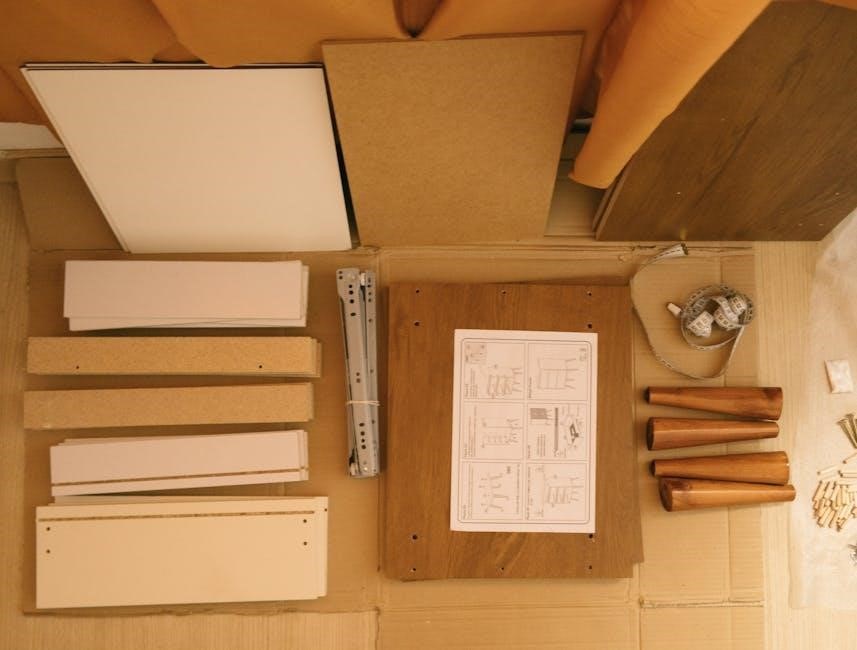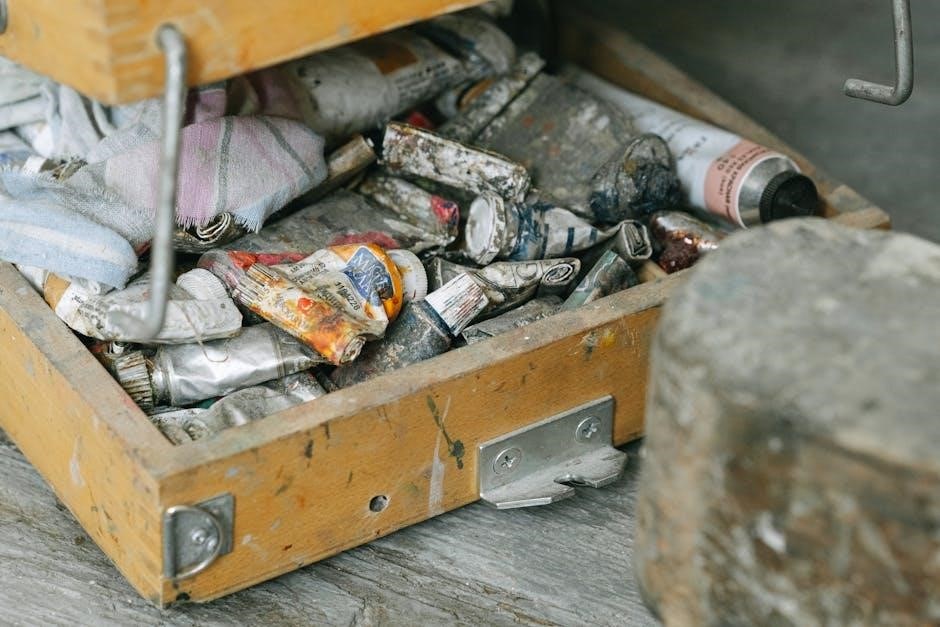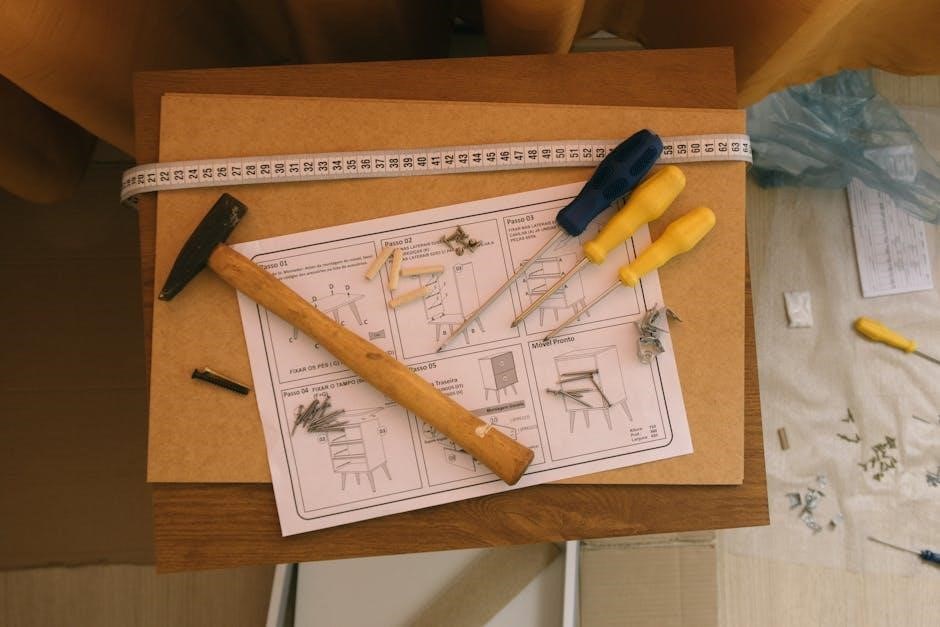Drawer guide kits are essential for smooth drawer operation and durability․ They include various slide types, ensuring proper installation and maintenance for different drawer systems․
Types of Drawer Slides
Drawer slides are available in side-mount, center-mount, and under-mount types, each offering unique benefits․ Side-mount slides are durable and easy to install, while center-mount slides provide smooth operation․ Under-mount slides offer a sleek, hidden design for modern aesthetics․
Side-Mount Slides
Side-mount slides are a popular choice for drawer systems due to their durability and ease of installation․ They are ideal for heavy-duty applications and offer smooth operation․ These slides are typically mounted on the sides of the drawer and cabinet, providing excellent stability․ They come in various lengths and weight capacities, making them versatile for different projects․ Side-mount slides often feature a locking mechanism to prevent the drawer from tipping over, enhancing safety․ Their robust design ensures long-lasting performance, even under heavy use․ This type of slide is preferred by many DIY enthusiasts and professionals alike for its strength and ease of use․ With proper installation, side-mount slides deliver a smooth and reliable drawer operation, making them a practical solution for various furniture and cabinet needs․
Center-Mount Slides
Center-mount slides are designed for drawers requiring a single, central guide for operation․ They are ideal for lighter-duty applications and offer a sleek, minimalistic appearance․ These slides are mounted under the drawer and in the center of the cabinet, making them a great choice for smaller or narrower spaces․ They provide smooth, quiet operation and are often used in modern furniture designs where aesthetics are important․ Center-mount slides are typically easier to install compared to side-mount slides, as they require fewer mounting points․ They are suitable for lightweight drawers and are commonly found in bedrooms and bathrooms․ Their compact design makes them a practical solution for projects where space is limited․ Center-mount slides are a reliable option for homeowners seeking a simple yet effective drawer guide system․

Under-Mount Slides
Under-mount slides are a popular choice for drawer systems due to their durability and smooth operation․ They are mounted underneath the drawer and inside the cabinet, making them nearly invisible when the drawer is closed․ These slides are known for their heavy-duty capacity and are ideal for larger, heavier drawers․ They often feature a full-extension design, allowing the drawer to open completely for easy access․ Under-mount slides typically use rollers or ball bearings for smooth gliding and are available in various lengths to suit different applications․ They are a great option for kitchen cabinets, office furniture, and other spaces where functionality and strength are prioritized․ Under-mount slides are also easy to install with the right tools and are widely available in repair kits, making them a practical choice for both new installations and renovations․

Installation Process
Installing drawer slides requires precise measurements and alignment․ Ensure the drawer and cabinet are properly marked, then secure the slides using screws․ A drill and measuring tape are essential tools for accurate fitting․ Proper installation ensures smooth drawer operation and longevity of the slides․ Alignment and leveling are critical to prevent uneven movement․ Follow the manufacturer’s instructions for specific mounting configurations, such as side-mount or under-mount setups․ Pre-drilling holes can help avoid splitting wood․ After installation, test the drawer to ensure it glides smoothly and adjust if necessary․ Correct installation enhances functionality and durability, making the drawer system more efficient and user-friendly․ Patience and attention to detail are key for a successful installation․ Cleaning debris and lubricating slides post-installation can further improve performance․ Always double-check measurements to avoid mistakes․ With careful planning, installation can be completed efficiently, even for DIY enthusiasts․ Professional tools may be needed for complex configurations․ Properly installed slides ensure years of trouble-free use, making the effort worthwhile․ Regular maintenance, like lubrication, can extend the life of the slides and maintain optimal performance․ Understanding the installation process thoroughly ensures a seamless experience, whether for new setups or repairs․ Following step-by-step guides can simplify the task, especially for those new to furniture hardware․ Ensuring all components are securely fastened prevents future issues, such as loose screws or misaligned drawers․ The installation process, while detailed, is manageable with the right preparation and tools, leading to a professional-looking result․ By adhering to these steps, anyone can achieve a well-installed drawer slide system tailored to their needs․ Proper installation not only enhances functionality but also adds aesthetic value to the furniture․ Taking the time to do it right ensures satisfaction and longevity of the drawer system․ The effort invested in correct installation pays off in the long run with reliable performance and minimal maintenance․ With these considerations in mind, the installation process can be both rewarding and effective, providing a sturdy and efficient drawer system for years to come․
Steps for Installation
Begin by measuring the drawer and cabinet to ensure proper alignment․ Mark the mounting points for both the drawer and cabinet slides using a pencil․ Secure the slides to the drawer and cabinet using the provided screws, ensuring they are tightly fastened․ Attach the drawer to the slides by aligning the corresponding parts and sliding them into place․ Test the drawer’s movement to ensure smooth operation․ If necessary, adjust the slides for proper alignment and even spacing․ Tighten all screws once the drawer is functioning correctly․ Finally, clean any debris and apply lubrication to the slides for optimal performance․ Regularly check and maintain the slides to prevent wear and tear․ Following these steps ensures a secure and functional installation, enhancing the drawer’s usability and longevity․
Tools Needed for Installation
To install drawer slides, essential tools include a screwdriver for securing the slides, a measuring tape for accurate alignment, and a drill for pre-drilling holes if necessary․ Clamps can help hold the slides in place during installation, while a wrench or Allen key may be needed for adjusting certain mechanisms․ A utility knife can be useful for trimming excess material, and a level ensures proper alignment․ Lubrication, such as bar soap or WD40, is often recommended to enhance smooth operation․ Safety gear like gloves and goggles is also advisable to protect against accidental injuries․ Having these tools ready ensures a efficient and precise installation process, allowing the drawer to function smoothly and reliably․ Proper preparation with the right tools minimizes errors and guarantees a professional-quality result, making the installation process both effective and stress-free․
Repair Methods

Common issues include bent slides, loose screws, and dust buildup․ Straighten slides with pliers, lubricate with bar soap or WD40, and tighten screws for smooth operation․ Cleaning debris ensures proper functionality and extends the life of the drawer system․
Common Issues in Drawer Slides

Drawer slides often face issues like bent or misaligned tracks, which can cause drawers to wobble or stick․ Loose screws may lead to instability, while dust and debris buildup can hinder smooth operation․ Over time, rollers or ball bearings may wear out, resulting in noisy or difficult drawer movement․ Additionally, improper installation or mismatched slide types can lead to poor functionality․ Moisture exposure might rust metal components, further complicating the issue․ Addressing these problems promptly ensures longevity and optimal performance of the drawer system;
Effective Solutions for Repair
Effective solutions for repairing drawer slides often involve simple yet precise steps․ Straightening bent slides with pliers or lubricating tracks with bar soap or WD40 can restore smooth operation․ Tightening loose screws and cleaning dust and debris from the tracks are quick fixes that prevent further damage․ For more severe issues, replacing worn-out rollers or ball bearings with a drawer guide kit is recommended․ Ensure the replacement parts match the original type and length for proper functionality․ Regular maintenance, such as lubricating moving parts and inspecting for alignment, can prevent future problems․ Additionally, installing drawer slides correctly, with precise measurements and secure fastening, minimizes the risk of damage․ Using a high-quality drawer guide kit tailored to the specific drawer type ensures durability and optimal performance, making repairs both efficient and long-lasting․

Choosing the Right Kit

Selecting the right drawer guide kit involves considering the drawer type, slide mechanism, and material․ Ensure the kit matches your drawer’s size, weight capacity, and mounting style for optimal performance․
Factors to Consider
When selecting a drawer guide kit, several factors must be evaluated to ensure the best fit for your needs․ First, consider the type of drawer and its intended use, as this determines the required durability and weight capacity of the slides․ The size and thickness of the drawer, as well as the cabinet’s dimensions, are critical for proper alignment and smooth operation․ Additionally, the material of the drawer and cabinet—whether wood, metal, or another substance—will influence the compatibility of the kit․ The slide mechanism, such as ball-bearing or rolling, should be chosen based on desired smoothness and noise levels․ Finally, assess the ease of installation and whether additional tools or hardware are required․ By evaluating these factors, you can choose a kit that enhances functionality and longevity․ Proper alignment and material compatibility ensure a seamless fit․ Always check product specifications to match your project’s requirements․
Recommendations for Selection
When selecting a drawer guide kit, prioritize durability, smooth operation, and compatibility․ Opt for ball-bearing slides for heavy-duty use, as they offer superior smoothness and weight capacity․ For quieter operation, consider soft-close or dampened slides, especially in kitchens or bedrooms․ Full-extension slides are ideal for easy access to the drawer’s entire contents․ Ensure the kit matches your drawer’s material—wood or metal—and its size for proper fitment․ Epoxy-coated or rust-resistant options are recommended for humid environments․ Check the weight rating to ensure it can handle your drawer’s load․ Additionally, consider the ease of installation; some kits include pre-drilled holes or adjustable brackets for convenience․ Reading reviews and product specifications can help you make an informed decision․ Always verify compatibility with your cabinet type, whether side-mount, center-mount, or under-mount, to ensure a seamless installation and optimal performance․
